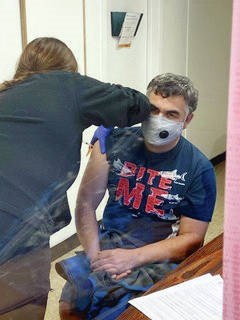More than a quarter of the almost 16,000 Indigenous people in B.C. who have been vaccinated against COVID-19 are on Vancouver Island.
Sixteen rural and remote First Nations communities on the Island — including some with outbreaks — have received first doses, while five communities have immunization clinics underway, and another 30 have yet to receive immunizations, First Nations Health Authority executives said during a media availability Tuesday on the vaccine rollout.
Acting chief medical officer Dr. Shannon McDonald said the vaccine shortage has posed the biggest challenge to the rollout, but the health authority hopes all First Nations communities will have the opportunity to receive vaccines by the end of March. She added that vaccinating the urban Indigenous population will likely take longer.
First Nations communities are primarily receiving the Moderna vaccine, but use of the Pfizer vaccine is being considered, given the delays.
“We have used every single dose that we have been given to vaccinate as many people as possible — starting with our most remote communities and moving inwards — recognizing communities that have had significant clusters,” said MacDonald.
Across B.C., more than 90 of 203 First Nations communities have had vaccines administered — mostly first doses — and doses are en route to another 12 First Nations communities, said Becky Palmer, chief nursing officer. The health authority said it’s working with provincial partners to ensure all 203 communities have vaccine “as soon as possible.”
About 42,000 doses are needed to provide a first shot of the vaccine to everyone living on First Nations reserves in B.C., said MacDonald.
As of Friday, there were 426 active cases of COVID-19 among Indigenous people in B.C., 185 of whom live on reserves. “We have seen the numbers steadily climbing,” said MacDonald, adding that while variants have been a cause for concern, “so far we have not seen that among the cases in our communities or our urban populations.”
Of the communities experiencing clusters, many are seeing cases down, said MacDonald.
Cowichan Tribes in Duncan continues to enforce a stay-at-home order. Between Dec. 31 and Feb. 8, it saw 195 members test positive and 186 recover, leaving five in isolation and three hospitalized. As of Feb. 8, there had been one death.
The Snuneymuxw First Nation in Nanaimo ended its shelter-in-place order on Jan. 20 after the province advised the outbreak had been contained, but on Feb. 5, as a result of mobile testing, five new COVID-19 cases were reported in students.
Province-wide, at least 68 First Nations members’ deaths have been related to COVID-19, 38 of whom were living on reserve, said MacDonald.
In addition to the approximately 16,000 people vaccinated through the First Nations Health Authority, another 3,000 Indigenous people have received shots in urban clinics.
Those living on reserves have been prioritized because they have less access to acute care.
Mass-vaccination clinics in B.C. are planned for April through September, starting with those ages 75 to 79 and moving down in five-year age increments.
B.C. Premier John Horgan has said the province plans to vaccinate all eligible residents by the end of September or early October.
The province is set to release more detailed COVID-19 case counts to Indigenous communities, as requested by the Nuu-chah-nulth Tribal Council, which represents 14 nations along the west coast of Vancouver Island.
Provincial health officer Dr. Bonnie Henry has said she will provide the Heiltsuk Nation, Nuu-chah-nulth Tribal Council Member Nations and Tsilhqot’in National Government with regular reports on the number of infections in their communities.
The First Nations say they need more specific information to inform decision making around restrictions and guidance for members.



